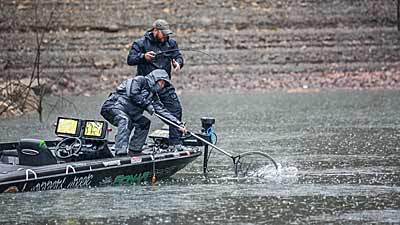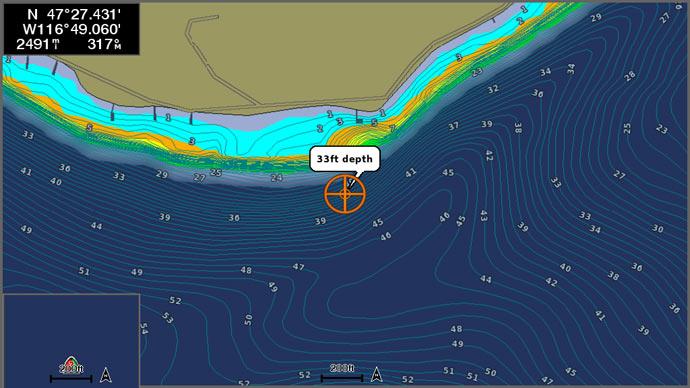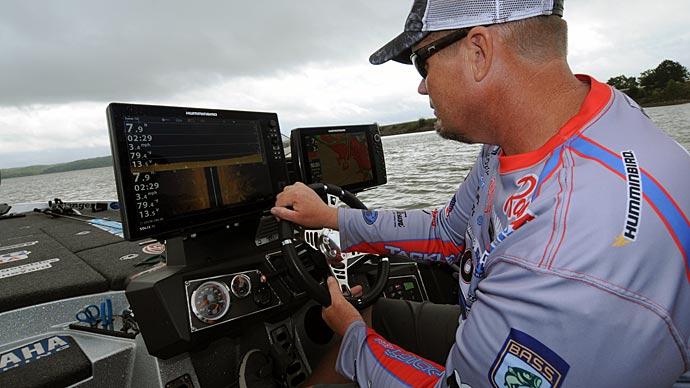
Keeping up with the latest bass-fishing technology is a never-ending process. Even competitors at the top level of bass tournaments are constantly adjusting and learning.
Forward-facing sonar, which provides a real-time view of what’s happening in whichever direction its trolling motor-mounted transducer is pointed, has stormed onto the bass-fishing scene. “I didn’t know anything about forward-facing sonar at the start of last summer,” said Major League Fishing and Bass Pro Tour angler Justin Lucas. But he did by its end. The technology helped him chase down enough smallmouth to win a Bass Pro Tour stage on Wisconsin’s Sturgeon Bay in July and the Tackle Warehouse Pro Circuit Super Tournament on Lake Erie a month later.
Adding or upgrading fishing electronics is a big step for many bass anglers. It’s an investment: The latest do amazing things with equally amazing price tags. Then there are the choices, starting with the brand, screen size, function, and capabilities. But if you’re determined to start the new season with new units, there are ways to find the best ones, whatever your budget and needs.
Trent Palmer owns Dawsonville, Georgia-based SonarPros. When retailers pause for a deep breath after the holiday shopping season, their business is ramping up. “Every day, we’re getting [wiring] harnesses out the door and rigging boats,” he said. That help is widespread, from top tournament pros prepping this year’s boat to weekend anglers adding a unit or two to their trusty ride, taking advantage of developing technology.
Palmer rigs various electronics — brands, sizes, functions — on his customers’ bass boats. But this year, nearly all are asking for forward-facing sonar, he said. Garmin’s Panoptix Livescope leads that technology. On nearby Lake Lanier, where giant spotted bass suspend around brush piles and along timber lines, it’s seen as essential by many anglers, including Paul Mueller. He used it to win a Bassmaster Elite Series event there in 2019. “If you don’t have Livescope on your boat and you’re fishing [tournaments on] Lake Lanier, then you’re getting beat,” he said.
Lowrance recently added to the real-time sonar game with ActiveTarget. Palmer is impressed by it and Livescope. That understanding isn’t from sales but the on-the-water experience. When he’s not rigging electronics, he’s fishing tournaments, logging a top-10 finish at the recent Toyota Series Championship on Kentucky’s Lake Cumberland and a BFL win on Lake Hartwell, which South Carolina and Georgia share.
What Do I Need?
SonarPros works in the bass-fishing market, so nearly all its instillations are Garmin, Humminbird, or Lowrance electronics. “When it comes to which one, it’s like the old argument Ford vs. Chevy,” Palmer said. “Everyone has their favorite.”

Sometimes the brand choice is function-driven. Palmer’s boat, for example, sports three Lowrance units and one Garmin, which runs Livescope. And he’s adding ActiveTarget this year. For example, other customers have added one Humminbird unit to access detailed LakeMaster mapping.
But brand loyalty only gets you started. “What you do and what you fish determines where you’re going to get the biggest bang for your buck,” he said. While forward-facing sonar, for example, would be excellent for an upcoming trip to catch Great Lakes smallmouth, it’s the wrong investment if your local lakes are shallow and filled with aquatic vegetation. Humminbird’s MEGA 360 Imaging would be better. He said it reveals the bigger picture, including holes in and edges of the grass around your boat.
It’s different if you spend the most time fishing deep open water, where you’re searching for individual targets. “Then all your money should be dedicated to [forward-facing sonar],” Palmer said. And Lowrance, with its ActiveTarget live sonar, may be your best choice. He said Lowrance units excel at managing large numbers of waypoints and can run C-MAP or Navionics mapping.
Consider a unit’s processing power. Palmer said more is usually better, something you can experience at your local dealer. Flip through the screens and functions on a test model; the faster you can go, the more processing power is in the unit. The most powerful is never slow, even when you ask it to remember more and more navigation trails, icons, and waypoints.
Screen size — some units approach small-TV status — may grab the most attention. “In theory, bigger is better,” Palmer said. So, he recommends at least a 12-inch model for a console unit. That allows multiple functions to be easily seen on a split-screen. “It’s hard to see them all if it’s any smaller,” he said.
Palmer said a front-deck unit should have at least a 9-inch screen. That makes for easy viewing, even while standing. And if you’re running forward-facing sonar, he recommends dedicating a unit to it so it always has a full screen.
If buying multiple units isn’t in your budget — Palmer said two 12-inch units on the console, for example, is probably too much for a weekend angler to justify — keep running your old unit, especially if it’s compatible with your new one. For example, his expiration date for Lowrance units is the LLS 2 side-scan transducer. So, you’re good to go if that’s what yours uses. And on the Humminbird side, it would be a first-generation Helix, 1100 or 900.
Integrating your electronics with your trolling motor looks good on paper, but Palmer has only found a few uses for it in the bass-fishing world. For example, if you’re fishing an offshore spot and go to the back deck to land a bass without locking onto the spot, you may get blown off it. But if your electronics can talk to your trolling motor, you could lock down through a graph on the console.
If you’re in the market for a trolling motor, focus on what it brings to the table. A breakaway mount and brushless motor, which increases efficiency, are more important than integration capabilities in Palmer’s eyes, especially if your budget is tight.
If you’re purchasing two or more units, Palmer said it’s essential that they can communicate through a network, sharing information such as waypoints. It’s cool if they can talk to your outboard, too, but that’s not needed if your boat sports suitable gauges.
You’ll need to connect your electronics to your boat physically. “I can’t stand it when someone spends $3,000 or $6,000 on units and has a basic mounting,” Palmer said. He suggests investing in solid mounts such as BoatLogix or Bass Boat Technologies. They’ll hold your units, making them easy to see and use. The same mount depends on your boat and needs. “I like to have things neat and organized,” he said. That’s stacked on the front deck and centered — side by side if there are two — at the console.
How’s Your Transducer’s Attitude?
Manufacturers package the proper transducer with each unit, removing the guesswork of finding the correct one. But mounting an external one, such as what makes down and side scans possible, isn’t a straightforward process.
Palmer said boats don’t sit level in the water, even at rest. To improve performance, most of the weight, including fuel and batteries, is stowed toward the stern, which slightly raises the bow. Put its outboard in gear, and the bow only goes higher and the stern lower. He said that attitude must be considered when mounting an external transducer to ensure it reads true.
Start with your boat in the water and the outboard in gear. Then with a digital level or smartphone app, capture its attitude, using its deck as the plane. Palmer said to recreate that angle in your garage or driveway by raising or lowering the trailer jack. Once that’s established, adjust your transducer, so it’s level, usually about 2.5 to 2.9 positive degrees.
Check Your Wiring
Palmer fished his first tournament when he was in high school. He also learned about wiring 12-volt DC systems for high-end car audio. He could pack enough speaker power into a regular-cab truck to blow out its windshield.

Palmer’s tournament fishing continued into college. So, when the electronics started blinking on his bass boat, he went to work, taking what he learned from cars to assemble a wiring harness for his boat. That was about a decade ago. Since then, he’s helped friends rig their boats and started SonarPros about two years ago.
While upgrading your electronics is exciting, make sure your plans aren’t short-circuited. Palmer said they all need a bigger unit or more power. Feeding them isn’t much about stuffing a bigger battery into your boat. He said the solution is in your boat’s wires.
Many bass boats are factory rigged with 16- or 18-gauge wiring. Palmer said attempting to draw more power through it causes an amp load and voltage drop. You’ll see the adverse effects in several places — lagging units, compromised images, and batteries that drain faster. He said you’ll know that’s your problem if your unit displays 11.5 or fewer volts.
Palmer has a solution — independently wiring the power and ground for each unit. That ensures each, whether you have one, two, four, or more, has the power it needs. He’s a proponent of getting your hands dirty with this project if you’re a confident DIY’er. If you’re not or want to get on the water sooner, SonarPros offers plug-and-play wiring harnesses complete with waterproof connections.
Learn To Use Them
You’ve bought the latest and greatest fishing electronics. And you may feel pretty good rolling into the boat ramp with multiple units mounted on your boat. But that investment of money and time only pays off if you use them to catch more and bigger bass. Palmer said simply leaving them on the mapping function won’t cut it. Take time to learn how they work.
First, familiarize yourself with your new electronics, including reading the manual and surfing the internet for videos and articles about their use. Then take them to the water to truly understand how they work. Palmer suggests spending a few days on familiar water, where known spots make interpreting how your new units react easier. And forget your fishing gear so you can concentrate on learning.
Play with your new electronics’ settings — contrast, sensitivity, color palette — in each of its functions to see how they react. But before you touch any, Palmer said to take a screen picture. “Then you’ll know where you started and can get them back,” he said.
Palmer said to keep your fingers away from network settings. Even the slightest tweak here can drastically affect how your units communicate, creating significant issues. He’s heard all about them from customers calling from the water.
If you want personalized training, on-the-water classes are available. Palmer offers them, which are tailored to each student’s needs. If they are a rookie, he’ll go over the basics, how to use and read their units. Those with more experience receive help creating fishing efficiency, including where to best drop a waypoint in relation to submerged cover or structure.
There are no shortcuts to time on the water when it comes to being a better bass angler, whether learning new techniques or getting the most out of your electronics. “That’s what so much of fishing is,” Lucas said.




